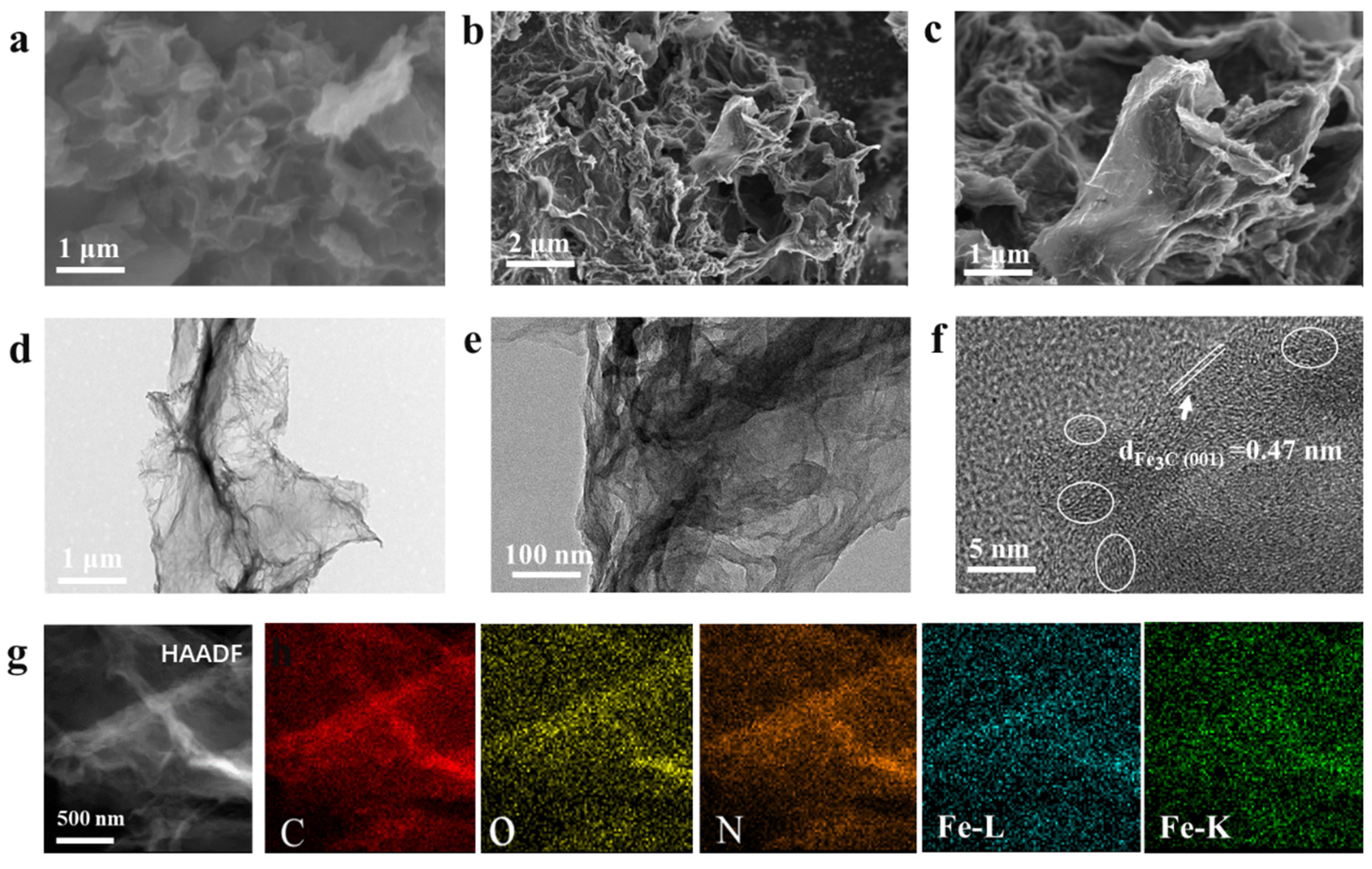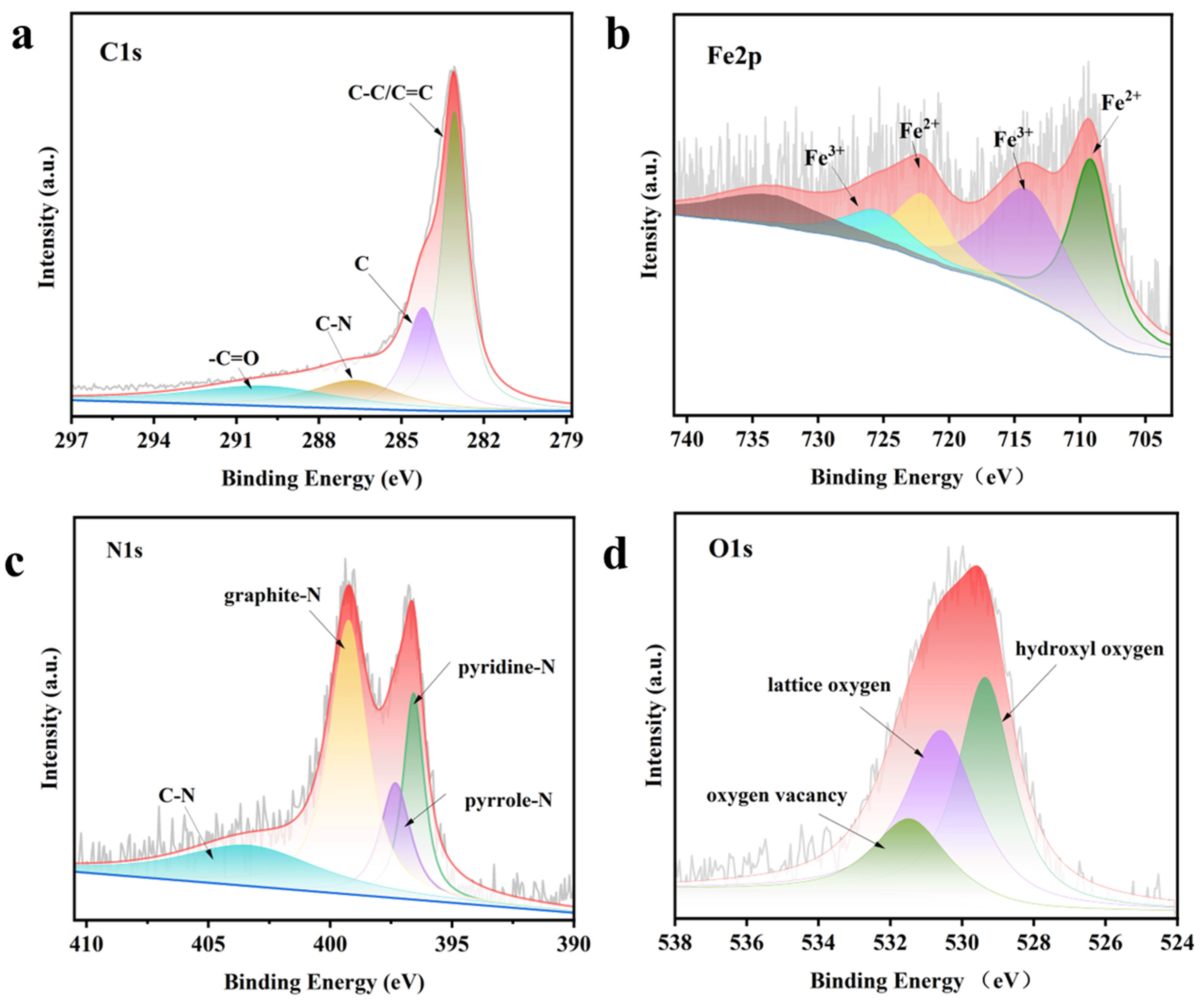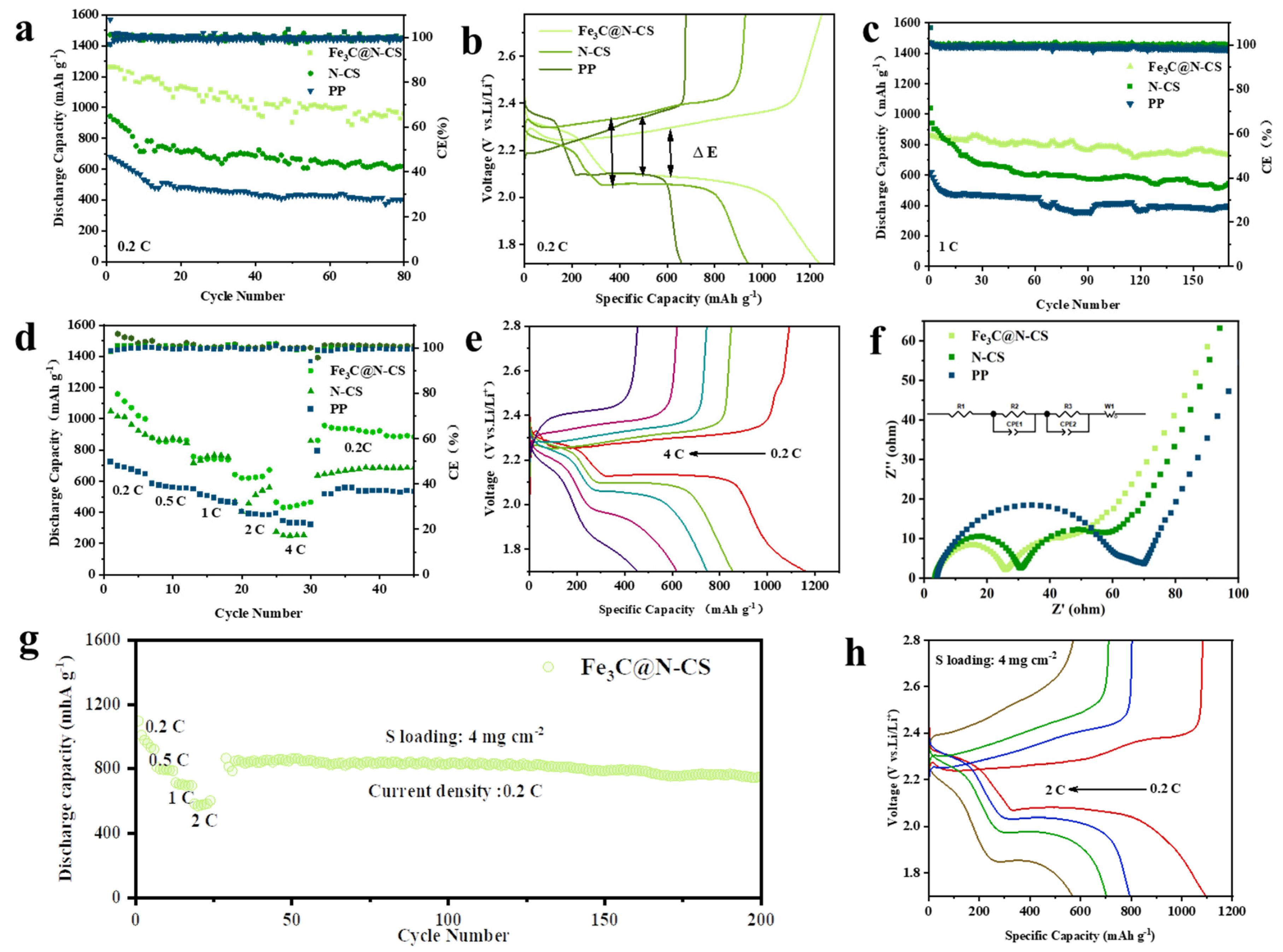Fe3C-Decorated Folic Acid-Derived Graphene-like Carbon-Modified Separator as a Polysulfide Barrier for High-Performance Lithium-Sulfur Batteries
Abstract
1. Introduction
2. Materials and Methods
2.1. Preparation of Fe3C@N-CS Carbon Sheet
2.2. Fabrication of Fe3C@N-CS-Coated Separator
2.3. Synthesis of Lithium Li2S6 Solution
2.4. Preparation of Cathodes
2.5. Electrochemical Measures
2.6. Material Characterization
3. Results and Discussion
4. Conclusions
Supplementary Materials
Author Contributions
Funding
Data Availability Statement
Conflicts of Interest
References
- Manthiram, A.; Fu, Y.; Chung, S.-H.; Zu, C.; Su, Y.-S. Rechargeable Lithium–Sulfur Batteries. Chem. Rev. 2014, 114, 11751–11787. [Google Scholar] [CrossRef]
- Yan, J.; Liu, X.; Li, B. Capacity Fade Analysis of Sulfur Cathodes in Lithium–Sulfur Batteries. Adv. Sci. 2016, 3, 1600101. [Google Scholar] [CrossRef]
- Liang, X.; Hart, C.; Pang, Q.; Garsuch, A.; Weiss, T.; Nazar, L.F. A highly efficient polysulfide mediator for lithium–sulfur batteries. Nat. Commun. 2015, 6, 5682. [Google Scholar] [CrossRef]
- Bhargav, A.; He, J.; Gupta, A.; Manthiram, A. Lithium-Sulfur Batteries: Attaining the Critical Metrics. Joule 2020, 4, 285–291. [Google Scholar] [CrossRef]
- Jiang, F.-N.; Yang, S.-J.; Chen, Z.-X.; Liu, H.; Yuan, H.; Liu, L.; Huang, J.-Q.; Cheng, X.-B.; Zhang, Q. Higher-order polysulfides induced thermal runaway for 1.0 Ah lithium sulfur pouch cells. Particuology 2023, 79, 10–17. [Google Scholar] [CrossRef]
- Wang, S.-M.; Li, H.-N.; Zhao, G.-F.; Xu, L.-F.; Liu, D.-L.; Sun, Y.-J.; Guo, H. Ni3FeN anchored on porous carbon as electrocatalyst for advanced Li–S batteries. Rare Met. 2022, 42, 515–524. [Google Scholar] [CrossRef]
- Tan, K.; Liu, Y.; Tan, Z.; Zhang, J.; Hou, L.; Yuan, C. High-yield and in situ fabrication of high-content nitrogen-doped graphene nanoribbons@Co/CoOOH as an integrated sulfur host towards Li–S batteries. J. Mater. Chem. A 2020, 8, 3048–3059. [Google Scholar] [CrossRef]
- Pang, Y.; Wei, J.-S.; Wang, Y.; Xia, Y. Synergetic Protective Effect of the Ultralight MWCNTs/NCQDs Modified Separator for Highly Stable Lithium-Sulfur Batteries. Adv. Energy Mater. 2018, 8, 1702288. [Google Scholar] [CrossRef]
- Chen, C.; Jiang, Q.; Xu, H.; Zhang, Y.; Zhang, B.; Zhang, Z.; Lin, Z.; Zhang, S. Ni/SiO2/Graphene-modified separator as a multifunc-tional polysulfide barrier for advanced lithium-sulfur batteries. Nano Energy 2020, 76, 105033. [Google Scholar] [CrossRef]
- Jiang, F.-N.; Yang, S.-J.; Cheng, X.-B.; Shi, P.; Ding, J.-F.; Chen, X.; Yuan, H.; Liu, L.; Huang, J.-Q.; Zhang, Q. Thermal safety of dendritic lithium against non-aqueous electrolyte in pouch-type lithium metal batteries. J. Energy Chem. 2022, 72, 158–165. [Google Scholar] [CrossRef]
- Zhang, B.; Wu, J.; Gu, J.; Li, S.; Yan, T.; Gao, X.-P. The Fundamental Understanding of Lithium Polysulfides in Ether-Based Electrolyte for Lithium–Sulfur Batteries. ACS Energy Lett. 2021, 6, 537–546. [Google Scholar] [CrossRef]
- Nie, Y.; Dai, X.; Wang, J.; Qian, Z.; Wang, Z.; Guo, H.; Yan, G.; Jiang, D.; Wang, R. Facile and scalable fabrication of lithiophilic Cu O enables stable lithium metal anode. J. Energy Chem. 2022, 75, 285–292. [Google Scholar] [CrossRef]
- Feng, J.; Li, J.; Zhang, H.; Liu, W.; Lin, Z.; Wang, T.; Zhao, X.; Wang, F.; Song, J. Accelerating redox kinetics by ZIF-67 derived amorphous cobalt phosphide electrocatalyst for high-performance lithium-sulfur batteries. Energy Mater. 2023, 3, 4130122. [Google Scholar] [CrossRef]
- Liu, H.; Liu, X.; Li, W.; Guo, X.; Wang, Y.; Wang, G.; Zhao, D. Porous Carbon Composites for Next Generation Rechargeable Lithium Batteries. Adv. Energy Mater. 2017, 7, 1700283. [Google Scholar] [CrossRef]
- Xie, C.; Shan, H.; Song, X.; Chen, L.; Wang, J.; Shi, J.-W.; Hu, J.; Zhang, J.; Li, X. Flexible S@C-CNTs cathodes with robust mechanical strength via blade-coating for lithium-sulfur batteries. J. Colloid Interface Sci. 2021, 592, 448–454. [Google Scholar] [CrossRef] [PubMed]
- Li, S.; Chen, X.; Hu, F.; Zeng, R.; Huang, Y.; Yuan, L.; Xie, J. Cobalt-embedded carbon nanofiber as electrocatalyst for polysulfide redox reaction in lithium sulfur batteries. Electrochim. Acta 2019, 304, 11–19. [Google Scholar] [CrossRef]
- Wang, D.; Zhao, Z.-Y.; Wang, P.; Wang, S.-M.; Feng, M. Synthesis of MOF-derived nitrogen-doped carbon microtubules via template self-consumption. Rare Met. 2022, 41, 2582–2587. [Google Scholar] [CrossRef]
- Hou, L.-P.; Zhang, X.-Q.; Li, B.-Q.; Zhang, Q. Challenges and promises of lithium metal anode by soluble polysulfides in practical lithium–sulfur batteries. Mater. Today 2021, 45, 62–76. [Google Scholar] [CrossRef]
- Zhang, Y.; Wei, C.; Wu, M.-X.; Wang, Y.; Jiang, H.; Zhou, G.; Tang, X.; Liu, X. A high-performance COF-based aqueous zinc-bromine battery. Chem. Eng. J. 2023, 451, 138915–138925. [Google Scholar] [CrossRef]
- Wang, P.; Xi, B.; Huang, M.; Chen, W.; Feng, J.; Xiong, S. Emerging Catalysts to Promote Kinetics of Lithium–Sulfur Batteries. Adv. Energy Mater. 2021, 11, 2002893. [Google Scholar] [CrossRef]
- Liu, X.; Huang, J.Q.; Zhang, Q.; Mai, L. Nanostructured Metal Oxides and Sulfides for Lithium-Sulfur Batteries. Adv. Mater. 2017, 29, 1601759. [Google Scholar] [CrossRef]
- Liu, G.; Yuan, C.; Zeng, P.; Cheng, C.; Yan, T.; Dai, K.; Mao, J.; Zhang, L. Bidirectionally catalytic polysulfide conversion by high-conductive metal carbides for lithium-sulfur batteries. J. Energy Chem. 2022, 67, 73–81. [Google Scholar] [CrossRef]
- Yang, J.L.; Cai, D.Q.; Lin, Q.; Wang, X.Y.; Fang, Z.Q.; Huang, L.; Wang, Z.J.; Hao, X.G.; Zhao, S.X.; Li, J.; et al. Regulating the Li2S deposition by grain boundaries in metal nitrides for stable lithium-sulfur batteries. Nano Energy 2022, 91, 106669. [Google Scholar] [CrossRef]
- Zuo, J.-H.; Gong, Y.-J. Applications of transition-metal sulfides in the cathodes of lithium–sulfur batteries. Tungsten 2020, 2, 134–146. [Google Scholar] [CrossRef]
- Tan, Z.; Li, H.; Feng, Q.; Jiang, L.; Pan, H.; Huang, Z.; Zhou, Q.; Zhou, H.; Ma, S.; Kuang, Y. One-pot synthesis of Fe/N/S-doped porous carbon nanotubes for efficient oxygen reduction reaction. J. Mater. Chem. A 2019, 7, 1607–1615. [Google Scholar] [CrossRef]
- Li, J.; Zhang, H.; Luo, L.; Li, H.; He, J.; Zu, H.; Liu, L.; Wang, F.; Song, J. Blocking polysulfides with a Janus Fe3C/N-CNF@RGO electrode via physiochemical confinement and catalytic conversion for high-performance lithium–sulfur batteries. J. Mater. Chem. A 2021, 9, 2205–2213. [Google Scholar] [CrossRef]
- Cao, Z.; Jia, J.; Chen, S.; Li, H.; Sang, M.; Yang, M.; Wang, X.; Yang, S. Integrating Polar and Conductive Fe2O3-Fe3C Interface with Rapid Polysulfide Diffusion and Conversion for High-Performance Lithium-Sulfur Batteries. ACS Appl. Mater. Interfaces 2019, 11, 39772–39781. [Google Scholar] [CrossRef] [PubMed]
- Pan, H.; Tan, Z.; Zhou, H.; Jiang, L.; Huang, Z.; Feng, Q.; Zhou, Q.; Ma, S.; Kuang, Y. Fe3C-N-doped carbon modified separator for high performance lithium-sulfur batteries. J. Energy Chem. 2019, 39, 101–108. [Google Scholar] [CrossRef]
- Song, J.; Guo, X.; Zhang, J.; Chen, Y.; Zhang, C.; Luo, L.; Wang, F.; Wang, G. Rational design of free-standing 3D porous MXene/rGO hybrid aerogels as polysulfide reservoirs for high-energy lithium–sulfur batteries. J. Mater. Chem. A 2019, 7, 6507–6513. [Google Scholar] [CrossRef]
- Li, J.; Song, J.; Luo, L.; Zhang, H.; Feng, J.; Zhao, X.; Guo, X.; Dong, H.; Chen, S.; Liu, H.; et al. Synergy of MXene with Se Infiltrated Porous N-Doped Carbon Nanofibers as Janus Electrodes for High-Performance So-dium/Lithium–Selenium Batteries. Adv. Energy Mater. 2022, 12, 2200894. [Google Scholar] [CrossRef]
- Tan, Z.; Liu, S.; Zhang, X.; Wei, J.; Liu, Y.; Hou, L.; Yuan, C. Few-layered V2C MXene derived 3D V3S4 nanocrystal functionalized carbon flakes boosting polysulfide adsorption and catalytic conversion towards Li–S batteries. J. Mater. Chem. A 2022, 10, 18679–18689. [Google Scholar] [CrossRef]
- Zhang, C.; Feng, J.; Guo, X.; Zhang, J.; Zhang, W.; Zhang, L.; Song, J.; Shao, G.; Wang, G. Blocking polysulfide by physical confinement and catalytic conversion of SiO2@MXene for Li–S battery. Appl. Phys. Lett. 2023, 122, 193901–193907. [Google Scholar] [CrossRef]
- Karimi, S.; Namazi, H. A photoluminescent folic acid-derived carbon dot functionalized magnetic dendrimer as a pH-responsive carrier for targeted doxorubicin delivery. New J. Chem. 2021, 45, 6397–6405. [Google Scholar] [CrossRef]
- Ali, T.; Yan, C. 2 D Materials for Inhibiting the Shuttle Effect in Advanced Lithium–Sulfur Batteries. Chemsuschem 2020, 13, 1447–1479. [Google Scholar] [CrossRef] [PubMed]
- Shi, C.; Song, J.; Zhang, Y.; Wang, X.; Jiang, Z.; Sun, T.; Zhao, J. Revealing the mechanisms of lithium-ion transport and conduction in composite solid polymer electrolytes. Cell Rep. Phys. Sci. 2023, 4, 101321–101337. [Google Scholar] [CrossRef]
- Wang, X.; Sun, J.; Li, T.; Song, Z.; Wu, D.; Zhao, B.; Xiang, K.; Ai, W.; Fu, X.-Z.; Luo, J.-L. Folic acid self-assembly synthesis of ultrathin N-doped carbon nanosheets with single-atom metal catalysts. Energy Storage Mater. 2021, 36, 409–416. [Google Scholar] [CrossRef]
- Yu, K.; Wang, X.; Yang, H.; Bai, Y.; Wu, C. Insight to defects regulation on sugarcane waste-derived hard carbon anode for sodi-um-ion batteries. J. Energy Chem. 2021, 55, 499–508. [Google Scholar] [CrossRef]
- Zhang, Y.; Zhao, R.; Li, Y.; Zhu, X.; Zhang, B.; Lang, X.; Zhao, L.; Jin, B.; Zhu, Y.; Jiang, Q. Potassium-ion batteries with novel N, O enriched corn silk-derived carbon as anode exhibiting excellent rate performance. J. Power Sources 2021, 481, 228644. [Google Scholar] [CrossRef]
- Wu, R.; Chen, S.; Deng, J.; Huang, X.; Song, Y.; Gan, R.; Wan, X.; Wei, Z. Hierarchically porous nitrogen-doped carbon as cathode for lithium–sulfur batteries. J. Energy Chem. 2018, 27, 1661–1667. [Google Scholar] [CrossRef]
- Liu, Y.; Yang, C.; Li, Y.; Zheng, F.; Li, Y.; Deng, Q.; Zhong, W.; Wang, G.; Liu, T. FeSe2/nitrogen-doped carbon as anode material for Potassium-ion batteries. Chem. Eng. J. 2020, 393, 124590. [Google Scholar] [CrossRef]
- Xiao, J.; Li, X.; Tang, K.; Wang, D.; Long, M.; Gao, H.; Chen, W.; Liu, C.; Liu, H.; Wang, G. Recent progress of emerging cathode materials for sodium ion batteries. Mater. Chem. Front. 2021, 5, 3735–3764. [Google Scholar] [CrossRef]
- Zhou, Z.; Chen, Z.; Lv, H.; Zhao, Y.; Wei, H.; Huai, G.; Xu, R.; Wang, Y. High-entropy nanoparticle constructed porous honeycomb as a 3D sulfur host for lithium polysulfide adsorption and catalytic conversion in Li–S batteries. J. Mater. Chem. A 2023, 11, 5883–5894. [Google Scholar] [CrossRef]
- Zhao, M.; Chen, X.; Li, X.; Li, B.; Huang, J. An Organodiselenide Comediator to Facilitate Sulfur Redox Kinetics in Lithium–Sulfur Batteries. Adv. Mater. 2021, 33, e2007298. [Google Scholar] [CrossRef] [PubMed]
- Li, L.; Liu, H.; Jin, B.; Sheng, Q.; Li, Q.; Cui, M.; Li, Y.; Lang, X.; Jiang, Q. Functional Separator Modified with Reduced Graphene Oxide and Fe3S4 for High-Performance Lithium–Sulfur Batteries. ACS Appl. Nano Mater. 2023, 6, 1161–1170. [Google Scholar] [CrossRef]
- Zhang, S.; Zhang, Y.; Ma, L.; Ma, C.; Zhang, C.; Chen, Y.; Chen, L.; Zhou, L.; Wei, W. Dual Active Sites of Oversaturated Fe-N(5) and Fe(2) O(3) Nanoparticles for Accelerating Redox Kinetics of Polysulfides. Small 2023, e2300293. [Google Scholar] [CrossRef] [PubMed]
- Huang, J.-Q.; Zhang, B.; Xu, Z.-L.; Abouali, S.; Akbari Garakani, M.; Huang, J.; Kim, J.-K. Novel interlayer made from Fe3C/carbon nanofiber webs for high performance lithium–sulfur batteries. J. Power Sources 2015, 285, 43–50. [Google Scholar] [CrossRef]
- Wang, S.; Liu, X.; Duan, H.; Deng, Y.; Chen, G. Fe3C/Fe nanoparticles embedded in N-doped porous carbon nanosheets and graphene: A thin functional interlayer for PP separator to boost performance of Li-S batteries. Chem. Eng. J. 2021, 415, 129001. [Google Scholar] [CrossRef]
- Wu, K.; Hu, Y.; Cheng, Z.; Pan, P.; Zhang, M.; Jiang, L.; Mao, J.; Ni, C.; Zhang, Y.; Wang, Z.; et al. Fe3C composite carbon nanofiber interlayer for efficient trapping and conversion of polysulfides in lithium-sulfur batteries. J. Alloy. Compd. 2020, 847, 156447. [Google Scholar] [CrossRef]
- Zhang, M.; Mu, J.; Li, Y.; Pan, Y.; Dong, Z.; Chen, B.; Guo, S.; Yuan, W.; Fang, H.; Hu, H.; et al. Propelling polysulfide redox by Fe3C-FeN heterostructure@nitrogen-doped carbon framework towards high-efficiency Li-S batteries. J. Energy Chem. 2023, 78, 105–114. [Google Scholar] [CrossRef]
- Zhu, R.; Lin, S.; Jiao, J.; Ma, D.; Cai, Z.; Hany, K.; Hamouda, T.M.; Cai, Y. Magnetic and mesoporous Fe3O4-modified glass fiber separator for high-performance lithium-sulfur battery. Ionics 2019, 26, 2325–2334. [Google Scholar] [CrossRef]






Disclaimer/Publisher’s Note: The statements, opinions and data contained in all publications are solely those of the individual author(s) and contributor(s) and not of MDPI and/or the editor(s). MDPI and/or the editor(s) disclaim responsibility for any injury to people or property resulting from any ideas, methods, instructions or products referred to in the content. |
© 2023 by the authors. Licensee MDPI, Basel, Switzerland. This article is an open access article distributed under the terms and conditions of the Creative Commons Attribution (CC BY) license (https://creativecommons.org/licenses/by/4.0/).
Share and Cite
Lin, Z.; Feng, J.; Liu, W.; Yin, L.; Chen, W.; Shi, C.; Song, J. Fe3C-Decorated Folic Acid-Derived Graphene-like Carbon-Modified Separator as a Polysulfide Barrier for High-Performance Lithium-Sulfur Batteries. Batteries 2023, 9, 296. https://doi.org/10.3390/batteries9060296
Lin Z, Feng J, Liu W, Yin L, Chen W, Shi C, Song J. Fe3C-Decorated Folic Acid-Derived Graphene-like Carbon-Modified Separator as a Polysulfide Barrier for High-Performance Lithium-Sulfur Batteries. Batteries. 2023; 9(6):296. https://doi.org/10.3390/batteries9060296
Chicago/Turabian StyleLin, Zenghui, Junan Feng, Wendong Liu, Lu Yin, Wanyang Chen, Chuan Shi, and Jianjun Song. 2023. "Fe3C-Decorated Folic Acid-Derived Graphene-like Carbon-Modified Separator as a Polysulfide Barrier for High-Performance Lithium-Sulfur Batteries" Batteries 9, no. 6: 296. https://doi.org/10.3390/batteries9060296
APA StyleLin, Z., Feng, J., Liu, W., Yin, L., Chen, W., Shi, C., & Song, J. (2023). Fe3C-Decorated Folic Acid-Derived Graphene-like Carbon-Modified Separator as a Polysulfide Barrier for High-Performance Lithium-Sulfur Batteries. Batteries, 9(6), 296. https://doi.org/10.3390/batteries9060296






